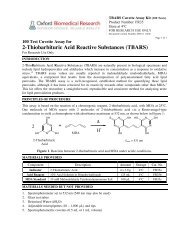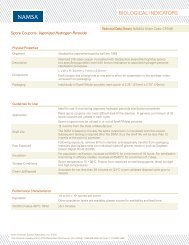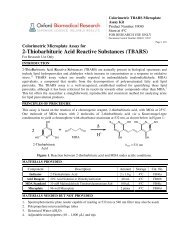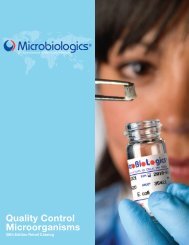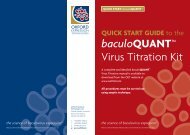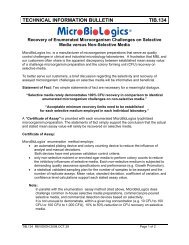flashBAC Manual - Oxford Expression Technologies
flashBAC Manual - Oxford Expression Technologies
flashBAC Manual - Oxford Expression Technologies
Create successful ePaper yourself
Turn your PDF publications into a flip-book with our unique Google optimized e-Paper software.
Insect cells have a relatively high dissolved oxygen content(DOC) requirement, particularly when infected with virus.Maintaining the appropriate DOC is important for cell growthand virus replication, and this can be achieved in shake,spinner and tissue culture flasks by using vented caps and notover-tightening lids. Most insect cells can be cultivated over atemperature range of 25-30°C. The optimal temperature for cellgrowth and infection for Sf21 and Sf9 cells is considered to be27-28°C.We recommend carrying out any cell culture work prior tohandling virus and only handling one cell line at a time. Alwaysuse a different bottle of cell culture medium for each cell line.The addition of antibiotics is optional (penicillin andstreptomycin prepared with 5 units/ml -1 penicillin G sodium and5 µl/ml -1 streptomycin sulphate in 0.85% saline can be used) butgenerally it is not recommended for virus amplification or proteinproduction. Certainly it is best to maintain stock cultureswithout antibiotics; otherwise you may be maintaining a lowlevelcontaminant that may cause inefficient virus replication orprotein production.The following is a general guide to preparing insect cells for theprotocols listed in section 8.10.1 Maintaining insect cells in suspension or monolayerculturesInsect cell lines can be maintained as either suspensioncultures, in shake or stirred flasks, or in monolayer cultures in Tflasks or dishes. Generally, insect cells adapted to serum-freemedium are cultivated in shake cultures with the aid of anOXFORD EXPRESSION TECHNOLOGIES 48



